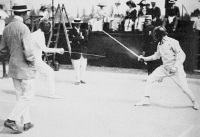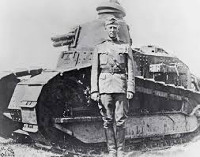General George Patton
Part 1: A Military Life George Patton was one of the most famous and instrumental generals in American military history. Supremely confident in his abilities, he was a far-sighted strategist and demanding commander whose technical brilliance was borne out in several key victories on the battlefields of Europe. His efforts after the D-Day invasion hastened the end of the war. Patton was born on Nov. 11, 1885, in San Gabriel, Calif. He was the descendent of Civil War veterans. He struggled to read and write but then mastered both and fostered a Patton married Beatrice Ayer in 1910. They had three children: Beatrice, Ruth Ellen, and George. 
He took time out from his military career to complete in the Olympics. The 1912 Summer Games were in Stockholm, and Patton competed in the modern pentathlon, a first-time competition that involved fencing, horse riding, running, shooting, and swimming. Of the 42 competitors, he finished fifth overall, after a dispute in the shooting competition. Patton argued that one of his bullets had actually travelled through a bullet hole he had made with a previous shot; the judges did not believe him. He was due to compete in the 1916 Olympics, but they were canceled after the start of World War I. Patton went to the Mounted Service School at Fort Riley, Kansas, in 1913 to serve as Master of the Sword, teaching swordsmanship. He studied fencing and designed a cavalry saber that came to be known as the Patton Saber. He joined in the American Expeditionary Force pursuit of Pancho Villa in Mexico in 1915 and 1916. 
Patton had made quite a study of the relatively new weapon the tank, especially in the World War I Battle of Cambrai, a British victory over Germany. He was considered so much of an expert that he was the first officer assigned to the tank corps of the American Expeditionary Force that arrived in Europe in 1917. Among his duties was to train Americans in operating the Renault tanks that the French Army was using. He fought in the Battle of St. Mihiel in September 1918 and the Battle of Meuse-Argonne, where he was wounded. An enemy machine gun blew a hole in his leg, and he commanded the battle for an hour in a shell hole before being evacuated, stopping at a command post to file his report before being taken to a hospital ward. After the war, the Army awarded him the Distinguished Service Medal for his tank efforts. Several years later, the Army awarded him the Purple Heart. After the war, he served at Camp Meade and earned the rank of captain. He wrote a manual on tank operations and developed his theory that tanks should spearhead an attack, not just support infantry actions. On July 28, 1932, Patton was at the head of a force of 600 cavalrymen who rode up and down Pennsylvania Avenue in Washington, D.C., in order to disperse a group of WWI veterans who had descended on the capital to demand cash for their veterans' bonus certificates. Next page > Rise to Prominence > Page 1, 2 |
|
Social Studies for Kids
copyright 2002–2025
David White



 lifelong love of reading, in particular military history and the biographies of famous conquerors. He attended the private Pasadena institution Stephen Clark's School for Boys. He grew up wanting to be a war hero and then became one. He went to the Virginia Military Institute in 1904 and then moved to the U.S. Military Academy. After repeating his first year because of bad grades, he graduated in 1909.
lifelong love of reading, in particular military history and the biographies of famous conquerors. He attended the private Pasadena institution Stephen Clark's School for Boys. He grew up wanting to be a war hero and then became one. He went to the Virginia Military Institute in 1904 and then moved to the U.S. Military Academy. After repeating his first year because of bad grades, he graduated in 1909.
